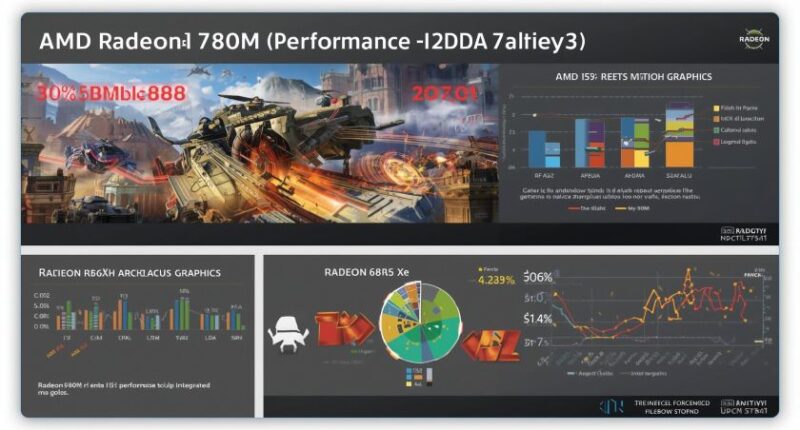In 2025, integrated graphics performance has seen massive improvements, and AMD Radeon 780M, powered by RDNA 3, is leading the way. When compared to its predecessors like the Radeon 680M and Intel Iris Xe, the 780M delivers impressive results in gaming and everyday tasks. In this article, we will dive into the gaming benchmarks, performance comparison, and overall value of the Radeon 780M against the Radeon 680M and Intel Iris Xe.
AMD Radeon 780M: RDNA 3 iGPU Revolution
The AMD Radeon 780M is part of AMD’s RDNA 3 architecture, which represents a significant leap in performance and efficiency for integrated graphics. It offers remarkable improvements over the previous generation, including better clock speeds, higher efficiency, and increased core counts. The Radeon 780M is designed to take full advantage of the Zen 4 architecture on AMD’s latest Ryzen 7000-series APUs, offering an iGPU that rivals entry-level discrete graphics cards in many situations.
Key Features of the Radeon 780M
-
Architecture: RDNA 3
-
Cores: Up to 12 Compute Units (768 stream processors)
-
Clock Speed: Boosts up to 3.0 GHz
-
Memory: Shared system memory with DDR5 support
-
Power Efficiency: Enhanced via RDNA 3 optimizations
-
DirectStorage & Ray Tracing Support: Available in compatible titles
With 12 compute units and a boost clock of 3.0 GHz, the Radeon 780M provides solid performance for a variety of gaming and creative applications, particularly in modern games optimized for RDNA 3.
Radeon 680M: A Predecessor Worth Considering
Before the arrival of the Radeon 780M, the Radeon 680M, built on RDNA 2 architecture, was AMD’s top integrated GPU. Found in the Ryzen 6000-series processors, it still offers impressive gaming performance for a wide range of titles.
Key Features of the Radeon 680M
-
Architecture: RDNA 2
-
Cores: 12 Compute Units (768 stream processors)
-
Clock Speed: Boosts up to 2.4 GHz
-
Memory: Shared system memory (DDR5, LPDDR5)
-
Performance: Great for casual gaming and light creative work
While it falls short compared to RDNA 3 in certain areas like ray tracing and power efficiency, the Radeon 680M is still a capable performer. It handles most games at 1080p resolution at medium settings, making it a good option for casual gamers or those who don’t mind dialing down graphics settings in more demanding titles.
Intel Iris Xe: Intel’s Integrated Power
Intel’s Iris Xe graphics, found in Intel Core 11th and 12th gen processors, is a direct competitor to AMD’s Radeon iGPUs. While not built for cutting-edge gaming, Intel’s Iris Xe is a solid performer for casual gamers, office productivity, and light creative work. It has seen continual improvements, but it still lacks the raw gaming performance of AMD’s RDNA-based GPUs.
Key Features of Intel Iris Xe
-
Architecture: Intel’s Gen 12 (Xe-LP)
-
Cores: Up to 96 Execution Units (EUs)
-
Clock Speed: Up to 1.65 GHz
-
Memory: Shared system memory (LPDDR4x/LPDDR5)
-
Performance: Suitable for 720p and 1080p gaming
Intel’s Iris Xe is a highly efficient integrated GPU, but it struggles to match the gaming performance of AMD’s RDNA-based iGPUs, especially in graphically demanding titles.
Gaming Performance: Radeon 780M vs. Radeon 680M vs. Intel Iris Xe
When comparing the gaming performance of the Radeon 780M, Radeon 680M, and Intel Iris Xe, the Radeon 780M emerges as the leader, particularly for modern gaming experiences.
Gaming Benchmarks: Radeon 780M vs. Radeon 680M vs. Intel Iris Xe
1. Cyberpunk 2077 (1080p, Medium Settings)
-
Radeon 780M: 45–50 FPS
-
Radeon 680M: 30–35 FPS
-
Intel Iris Xe: 20–25 FPS
In Cyberpunk 2077, a graphically demanding title, the Radeon 780M outperforms both the Radeon 680M and Intel Iris Xe by a significant margin. Thanks to RDNA 3, the 780M can handle 1080p gaming at medium settings with smoother frame rates.
2. Shadow of the Tomb Raider (1080p, High Settings)
-
Radeon 780M: 55–60 FPS
-
Radeon 680M: 35–40 FPS
-
Intel Iris Xe: 25–30 FPS
This action-adventure game shows how the Radeon 780M handles higher settings and more complex environments with ease. The 680M and Iris Xe, on the other hand, fall behind, struggling to maintain smooth gameplay at higher settings.
3. Fortnite (1080p, Epic Settings)
-
Radeon 780M: 90 FPS+
-
Radeon 680M: 60–70 FPS
-
Intel Iris Xe: 40–50 FPS
Fortnite, with its optimized graphics, performs excellently on the Radeon 780M, maintaining high frame rates at epic settings. The Radeon 680M holds up well at medium settings, but Intel Iris Xe struggles to keep up, especially at higher settings.
Performance in Productivity and Creative Work
While the primary strength of integrated graphics is gaming, AMD Radeon 780M and Radeon 680M can also boost productivity in creative tasks like video editing and 3D rendering.
-
Radeon 780M benefits from RDNA 3 optimizations, making it ideal for light video editing, 3D modeling, and rendering in applications like Adobe Premiere Pro or Blender.
-
The Radeon 680M still holds up for basic video editing but struggles with complex tasks like rendering 4K footage or handling large 3D scenes.
-
Intel Iris Xe is limited in performance for these tasks, especially for GPU-accelerated features, where RDNA 3 excels.
Power Efficiency and Thermals
One of the significant advantages of RDNA 3 over RDNA 2 (Radeon 680M) and Intel Iris Xe is power efficiency. AMD’s RDNA 3 architecture allows the Radeon 780M to deliver significantly better performance-per-watt, which helps in keeping system temperatures lower and extending battery life in laptops.
-
Radeon 780M: Best power efficiency with excellent performance.
-
Radeon 680M: Good power efficiency but slightly less efficient than the 780M.
-
Intel Iris Xe: Decent efficiency, but typically lags behind both AMD options.
Conclusion: Which iGPU Should You Choose?
-
For Gamers: If gaming is your priority, the Radeon 780M is clearly the best choice among the three. Its RDNA 3 architecture delivers superior gaming performance, especially at 1080p resolution. It’s ideal for casual to mid-level gamers who want a gaming-capable laptop without investing in a discrete GPU.
-
For Budget Gamers: The Radeon 680M is a great choice for budget-conscious gamers who can compromise on settings to get good frame rates in most modern games. It’s still a solid performer at medium settings.
-
For Casual or Office Use: If you’re looking for basic gaming or productivity with Intel-powered systems, the Intel Iris Xe is a fine option. It handles day-to-day tasks well but falls short in more demanding games or productivity tasks requiring GPU acceleration.









